Thermally Stratified Darcy Forchheimer Flow on a Moving Thin Needle with Homogeneous Heterogeneous Reactions and Non-Uniform Heat Source/Sink
Abstract
1. Introduction
2. Mathematical Formulation
3. Similarity Transformations
4. Numerical Methodology
5. Graphical Analysis
6. Conclusions
- ❖
- Higher values of result in the decline of velocity distribution as well as the thickness of the boundary layer.
- ❖
- Increments of and diminish the thermal boundary layer and temperature field.
- ❖
- The temperature field increases for non-uniform heat sources as they respond to heat generators, while signifies variable heat sinks that absorb heat and affirm the decline of and boundary layer thickness.
- ❖
- The concentration distribution is lessened with upgraded values of and that are the homogeneous and heterogeneous parameters,
- ❖
- The concentration profile increases for larger estimates of the Schmidt number.
Author Contributions
Acknowledgments
Conflicts of Interest
Nomenclature
| Component of velocity along the axial and radial direction | |
| Kinematic viscosity | |
| Size of needle | |
| Concentration of chemical species A∗, B∗ | |
| Small parameter depends on the nature of fluid | |
| Rate constants | |
| Temperature of fluid | |
| Reference temperature | |
| Temperature away from the surface | |
| Constant wall temperature | |
| Stream function in terms of component | |
| heat sink/source w.r.t space | |
| heat sink/source w.r.t time | |
| Internal heat generation | |
| Internal heat absorption | |
| A∗, B∗ | Chemical species |
| Local Reynold number | |
| Schmidt number | |
| Thermal conductivity | |
| Composite velocity | |
| Heat flux at wall | |
| Strength of heterogeneous reaction | |
| Constant velocity of needle | |
| Free stream velocity of fluid | |
| Thermal stratification | |
| Ratio of diffusion coefficient | |
| Ratio of needle velocity to composite velocity | |
| Ratio of diffusion coefficients (mass) | |
| Drag force coefficient | |
| Surface shear stress | |
| Coefficient of inertia | |
| Strength of homogeneous reaction | |
| Stream function | |
| Thermal diffusivity |
References
- Ramzan, M.; Gul, H.; Chung, J.D. Double stratified radiative Jeffery magneto nanofluid flow along an inclined stretched cylinder with chemical reaction and slip condition. Eur. Phys. J. Plus 2017, 132, 456. [Google Scholar] [CrossRef]
- Hayat, T.; Khan, M.I.; Farooq, M.; Alsaedi, A.; Khan, M.I. Thermally stratified stretching flow with Cattaneo–Christov heat flux. Int. J. Heat Mass Transf. 2017, 106, 289–294. [Google Scholar] [CrossRef]
- Mukhopadhyay, S.; Ishak, A. Mixed convection flow along a stretching cylinder in a thermally stratified medium. J. Appl. Math. 2012, 2012, 491695. [Google Scholar] [CrossRef]
- Eichhorn, R.; Lienhard, J.H.; Chen, C.-C. Natural convection from isothermal spheres and cylinders immersed in a stratified fluid. In International Heat Transfer Conference Digital Library; Begel House Inc.: Danbury, CT, USA, 1974. [Google Scholar]
- Kumar, B.V.R.; Singh, P. Effect of thermal stratification on free convection in a fluid-saturated porous enclosure. Numer. Heat Transf. Part A Appl. 1998, 34, 343–356. [Google Scholar] [CrossRef]
- Ramzan, M.; Liaquet, A.; Kadry, S.; Yu, S.; Nam, Y.; Lu, D. Impact of Second-Order Slip and Double Stratification Coatings on 3D MHD Williamson Nanofluid Flow with Cattaneo–Christov Heat Flux. Coatings 2019, 9, 849. [Google Scholar] [CrossRef]
- Paul, A.; Deka, R.K. Unsteady natural convection flow past an infinite cylinder with thermal and mass stratification. Int. J. Eng. Math. 2017, 2017, 8410691. [Google Scholar] [CrossRef]
- Ramzan, M.; Gul, H.; Kadry, S. Onset of Cattaneo-Christov Heat Flux and Thermal Stratification in Ethylene-Glycol Based Nanofluid Flow Containing Carbon Nanotubes in a Rotating Frame. IEEE Access 2019, 7, 146190–146197. [Google Scholar] [CrossRef]
- Ramzan, M.; Ullah, N.; Chung, J.D.; Lu, D.; Farooq, U. Buoyancy effects on the radiative magneto Micropolar nanofluid flow with double stratification, activation energy and binary chemical reaction. Sci. Rep. 2017, 7, 12901. [Google Scholar] [CrossRef]
- Ramzan, M.; Bilal, M.; Chung, J.D. Effects of thermal and solutal stratification on Jeffrey magneto-nanofluid along an inclined stretching cylinder with thermal radiation and heat generation/absorption. Int. J. Mech. Sci. 2017, 131, 317–324. [Google Scholar] [CrossRef]
- Hayat, T.; Hussain, T.; Shehzad, S.A.; Alsaedi, A. Thermal and concentration stratifications effects in radiative flow of Jeffrey fluid over a stretching sheet. PLoS ONE 2014, 9, e107858. [Google Scholar] [CrossRef]
- Ibrahim, W.; Makinde, O.D. The effect of double stratification on boundary-layer flow and heat transfer of nanofluid over a vertical plate. Comput. Fluids 2013, 86, 433–441. [Google Scholar] [CrossRef]
- Ramzan, M.; Bilal, M.; Chung, J.D. Influence of homogeneous-heterogeneous reactions on MHD 3D Maxwell fluid flow with Cattaneo-Christov heat flux and convective boundary condition. J. Mol. Liq. 2017, 230, 415–422. [Google Scholar] [CrossRef]
- Lu, D.; Li, Z.; Ramzan, M.; Shafee, A.; Chung, J.D. Unsteady squeezing carbon nanotubes-based nano-liquid flow with Cattaneo–Christov heat flux and homogeneous–heterogeneous reactions. Appl. Nanosci. 2019, 9, 169–178. [Google Scholar] [CrossRef]
- Suleman, M.; Ramzan, M.; Ahmad, S.; Lu, D.; Muhammad, T.; Chung, J.D. A Numerical Simulation of Silver–Water Nanofluid Flow with Impacts of Newtonian Heating and Homogeneous–Heterogeneous Reactions Past a Nonlinear Stretched Cylinder. Symmetry 2019, 11, 295. [Google Scholar] [CrossRef]
- Ramzan, M.; Bilal, M.; Chung, J.D. Effects of MHD homogeneous-heterogeneous reactions on third grade fluid flow with Cattaneo-Christov heat flux. J. Mol. Liq. 2016, 223, 1284–1290. [Google Scholar] [CrossRef]
- Suleman, M.; Ramzan, M.; Ahmad, S.; Lu, D. Numerical simulation for homogeneous–heterogeneous reactions and Newtonian heating in the silver-water nanofluid flow past a nonlinear stretched cylinder. Phys. Scr. 2019, 94, 085702. [Google Scholar] [CrossRef]
- Ramzan, M.; Shaheen, N. Thermally stratified Darcy–Forchheimer nanofluid flow comprising carbon nanotubes with effects of Cattaneo–Christov heat flux and homogeneous–heterogeneous reactions. Phys. Scr. 2019, 95, 015701. [Google Scholar] [CrossRef]
- Hayat, T.; Imtiaz, M.; Alsaedi, A.; Almezal, S. On Cattaneo–Christov heat flux in MHD flow of Oldroyd-B fluid with homogeneous–heterogeneous reactions. J. Magn. Magn. Mater. 2016, 401, 296–303. [Google Scholar] [CrossRef]
- Lu, D.; Ramzan, M.; Bilal, M.; Chung, J.D.; Farooq, U.; Tahir, S. On three-dimensional MHD Oldroyd-B fluid flow with nonlinear thermal radiation and homogeneous–heterogeneous reaction. J. Braz. Soc. Mech. Sci. Eng. 2018, 40, 387. [Google Scholar] [CrossRef]
- Lu, D.; Ramzan, M.; Ahmad, S.; Chung, J.D.; Farooq, U. A numerical treatment of MHD radiative flow of Micropolar nanofluid with homogeneous-heterogeneous reactions past a nonlinear stretched surface. Sci. Rep. 2018, 8, 12431. [Google Scholar] [CrossRef]
- Ramzan, M.; Bilal, M.; Chung, J.D. MHD stagnation point Cattaneo–Christov heat flux in Williamson fluid flow with homogeneous–heterogeneous reactions and convective boundary condition—A numerical approach. J. Mol. Liq. 2017, 225, 856–862. [Google Scholar] [CrossRef]
- Hayat, T.; Ijaz Khan, M.; Shehzad, S.A.; Imran Khan, M.; Alsaedi, A. Numerical simulation of Darcy–Forchheimer flow of third grade liquid with Cattaneo–Christov heat flux model. Math. Methods Appl. Sci. 2018, 41, 4352–4359. [Google Scholar] [CrossRef]
- Forchheimer, P. Wasserbewegung durch boden. Z. Ver. Deutsch Ing. 1901, 45, 1782–1788. [Google Scholar]
- Muskat, M. The flow of homogeneous fluids through porous media. Soil Sci. 1938, 46, 169. [Google Scholar] [CrossRef]
- Majeed, A.; Zeeshan, A.; Noori, F.M. Numerical study of Darcy-Forchheimer model with activation energy subject to chemically reactive species and momentum slip of order two. AIP Adv. 2019, 9, 045035. [Google Scholar] [CrossRef]
- Ganesh, N.V.; Hakeem, A.K.A.; Ganga, B. Darcy–Forchheimer flow of hydromagnetic nanofluid over a stretching/shrinking sheet in a thermally stratified porous medium with second order slip, viscous and Ohmic dissipations effects. Ain Shams Eng. J. 2016, 9, 939–951. [Google Scholar] [CrossRef]
- Abbasi, F.M.; Hayat, T.; Shehzad, S.A.; Alsaedi, A. Impact of Cattaneo-Christov heat flux on flow of two-types viscoelastic fluid in Darcy-Forchheimer porous medium. Int. J. Numer. Methods Heat Fluid Flow 2017, 27, 1955–1966. [Google Scholar] [CrossRef]
- Jawad, M.; Shah, Z.; Islam, S.; Bonyah, E.; Khan, A.Z. Darcy-Forchheimer flow of MHD nanofluid thin film flow with Joule dissipation and Navier’s partial slip. J. Phys. Commun. 2018, 2, 115014. [Google Scholar] [CrossRef]
- Sajid, T.; Sagheer, M.; Hussain, S.; Bilal, M. Darcy-Forchheimer flow of Maxwell nanofluid flow with nonlinear thermal radiation and activation energy. AIP Adv. 2018, 8, 035102. [Google Scholar] [CrossRef]
- Gireesha, B.J.; Mahanthesh, B.; Rashidi, M.M. MHD boundary layer heat and mass transfer of a chemically reacting Casson fluid over a permeable stretching surface with non-uniform heat source/sink. Int. J. Ind. Math 2015, 7, 247–260. [Google Scholar]
- Sravanthi, C.S. Slip flow of nanofluid over a stretching vertical cylinder in the presence of non-linear thermal radiation and non-uniform heat source/sink. Sci. Iran. Trans. B Mech. Eng. 2018, 25, 2098–2110. [Google Scholar] [CrossRef]
- Mabood, F.; Ibrahim, S.M.; Rashidi, M.M.; Shadloo, M.S.; Lorenzini, G. Non-uniform heat source/sink and Soret effects on MHD non-Darcian convective flow past a stretching sheet in a micropolar fluid with radiation. Int. J. Heat Mass Transf. 2016, 93, 674–682. [Google Scholar] [CrossRef]
- Sandeep, N.; Sulochana, C. Dual solutions for unsteady mixed convection flow of MHD micropolar fluid over a stretching/shrinking sheet with non-uniform heat source/sink. Eng. Sci. Technol. 2015, 18, 738–745. [Google Scholar] [CrossRef]
- Reddy, P.S.; Sreedevi, P.; Chamkha, A.J. MHD boundary layer flow, heat and mass transfer analysis over a rotating disk through porous medium saturated by Cu-water and Ag-water nanofluid with chemical reaction. Powder Technol. 2017, 307, 46–55. [Google Scholar] [CrossRef]
- Lee, L.L. Boundary layer over a thin needle. Phys. Fluids 1967, 10, 820–822. [Google Scholar] [CrossRef]
- Chen, J.L.S.; Smith, T.N. Forced convection heat transfer from nonisothermal thin needles. J. Heat Transf. 1978, 100, 358–362. [Google Scholar] [CrossRef]
- Ishak, A.; Nazar, R.; Pop, I. Boundary layer flow over a continuously moving thin needle in a parallel free stream. Chin. Phys. Lett. 2007, 24, 2895. [Google Scholar] [CrossRef]
- Chaudhary, M.A.; Merkin, J.H. A simple isothermal model for homogeneous-heterogeneous reactions in boundary-layer flow. I Equal diffusivities. Fluid Dyn. Res. 1995, 16, 311. [Google Scholar] [CrossRef]
- Chaudhary, M.A.; Merkin, J.H. Homogeneous-heterogeneous reactions in boundary-layer flow: Effects of loss of reactant. Math. Comput. Model. 1996, 24, 21–28. [Google Scholar] [CrossRef]
- Das, K.; Chakraborty, T.; Kundu, P.K. Analytical exploration of a TiO2 nanofluid along a rotating disk with homogeneous-heterogeneous chemical reactions and non-uniform heat source/sink. Eur. Phys. J. Plus 2017, 132, 555. [Google Scholar] [CrossRef]
- Hayat, T.; Farooq, M.; Alsaedi, A. Homogeneous-heterogeneous reactions in the stagnation point flow of carbon nanotubes with Newtonian heating. AIP Adv. 2015, 5, 027130. [Google Scholar] [CrossRef]
- Raju, S.S.; Kumar, K.G.; Rahimi-Gorji, M.; Khan, I. Darcy–Forchheimer flow and heat transfer augmentation of a viscoelastic fluid over an incessant moving needle in the presence of viscous dissipation. Microsyst. Technol. 2019, 25, 3399–3405. [Google Scholar] [CrossRef]
- Malik, R.; Khan, M. Numerical study of homogeneous–heterogeneous reactions in Sisko fluid flow past a stretching cylinder. Results Phys. 2018, 8, 64–70. [Google Scholar] [CrossRef]
- Ahmad, R.; Mustafa, M.; Hina, S. Buongiorno’s model for fluid flow around a moving thin needle in a flowing nanofluid: A numerical study. Chin. J. Phys. 2017, 55, 1264–1274. [Google Scholar] [CrossRef]
- Afridi, M.I.; Tlili, I.; Qasim, M.; Khan, I. Nonlinear Rosseland thermal radiation and energy dissipation effects on entropy generation in CNTs suspended nanofluids flow over a thin needle. Bound. Value Probl. 2018, 2018, 148. [Google Scholar] [CrossRef]
- Mehmood, K.; Hussain, S.; Sagheer, M. Mixed convection flow with non-uniform heat source/sink in a doubly stratified magnetonanofluid. AIP Adv. 2016, 6, 065126. [Google Scholar] [CrossRef]
- Salleh, S.N.A.; Bachok, N.; Arifin, N.M.; Ali, F.M. Numerical Analysis of Boundary Layer Flow Adjacent to a Thin Needle in Nanofluid with the Presence of Heat Source and Chemical Reaction. Symmetry 2019, 11, 543. [Google Scholar] [CrossRef]
- Afridi, M.I.; Qasim, M. Entropy generation and heat transfer in boundary layer flow over a thin needle moving in a parallel stream in the presence of nonlinear Rosseland radiation. Int. J. Therm. Sci. 2018, 123, 117–128. [Google Scholar] [CrossRef]
- Pal, D.; Mondal, H. Hydromagnetic convective diffusion of species in Darcy–Forchheimer porous medium with non-uniform heat source/sink and variable viscosity. Int. Commun. Heat Mass Transf. 2012, 39, 913–917. [Google Scholar] [CrossRef]
- Raees, A.; Wang, R.Z.; Xu, H. A homogeneous-heterogeneous model for mixed convection in gravity-driven film flow of nanofluids. Int. Commun. Heat Mass Transf. 2018, 95, 19–24. [Google Scholar] [CrossRef]
- Hayat, T.; Haider, F.; Muhammad, T.; Alsaedi, A. Darcy-Forchheimer flow with Cattaneo-Christov heat flux and homogeneous-heterogeneous reactions. PLoS ONE 2017, 12, e0174938. [Google Scholar] [CrossRef]
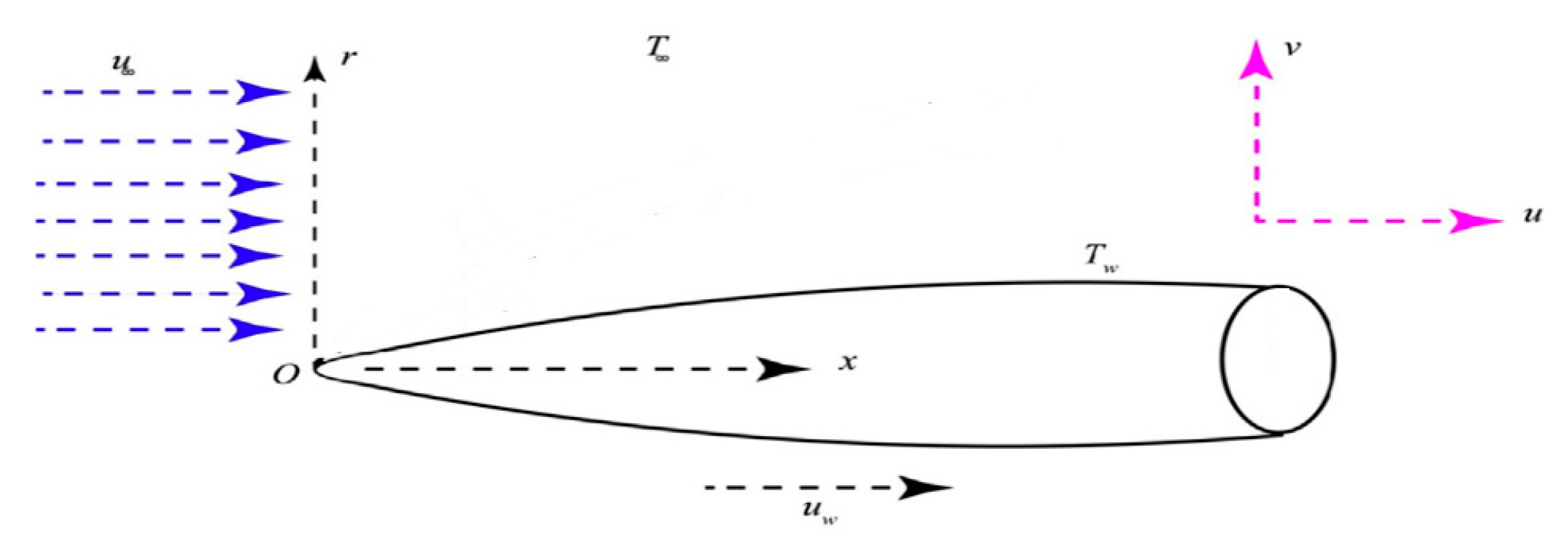
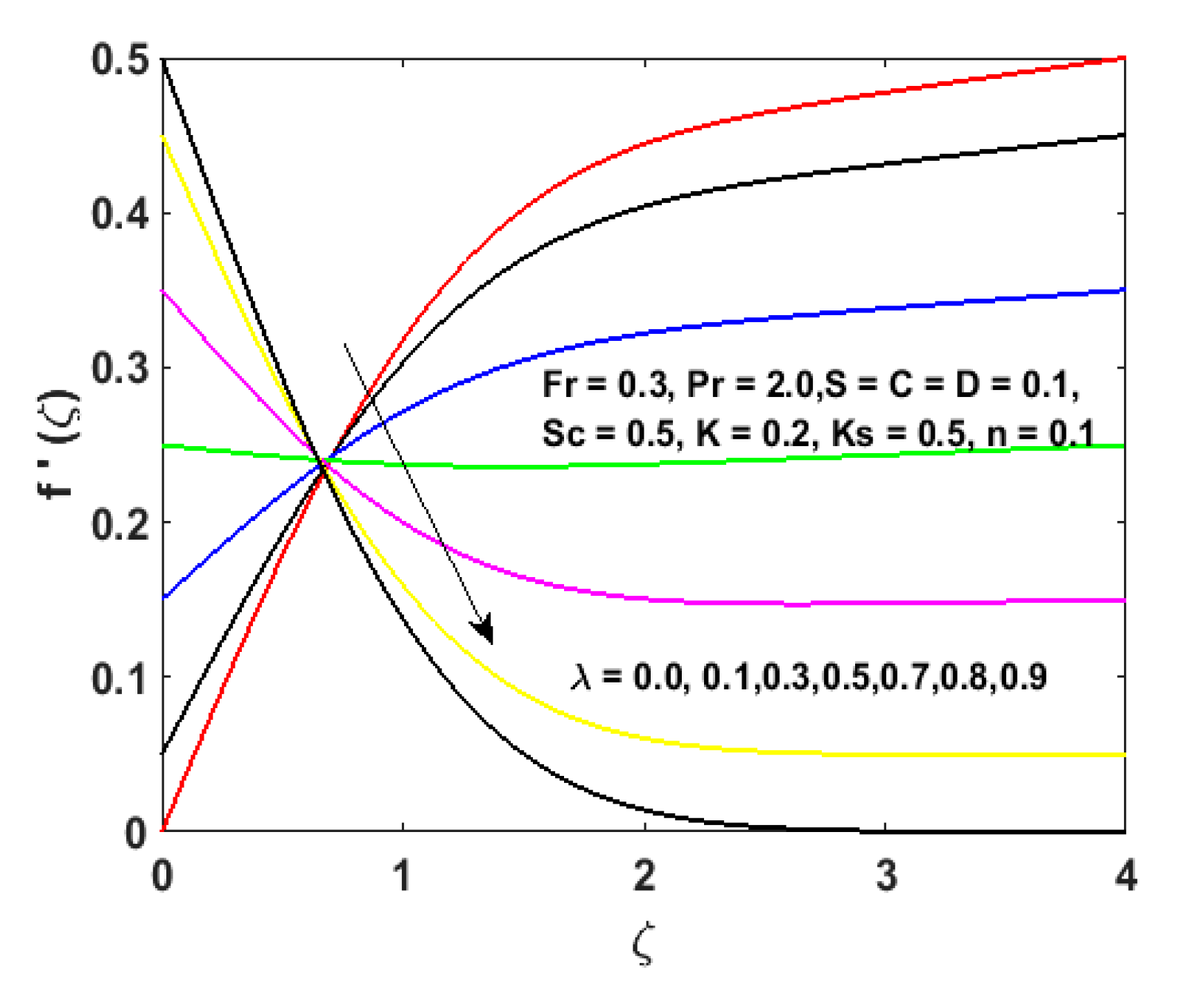
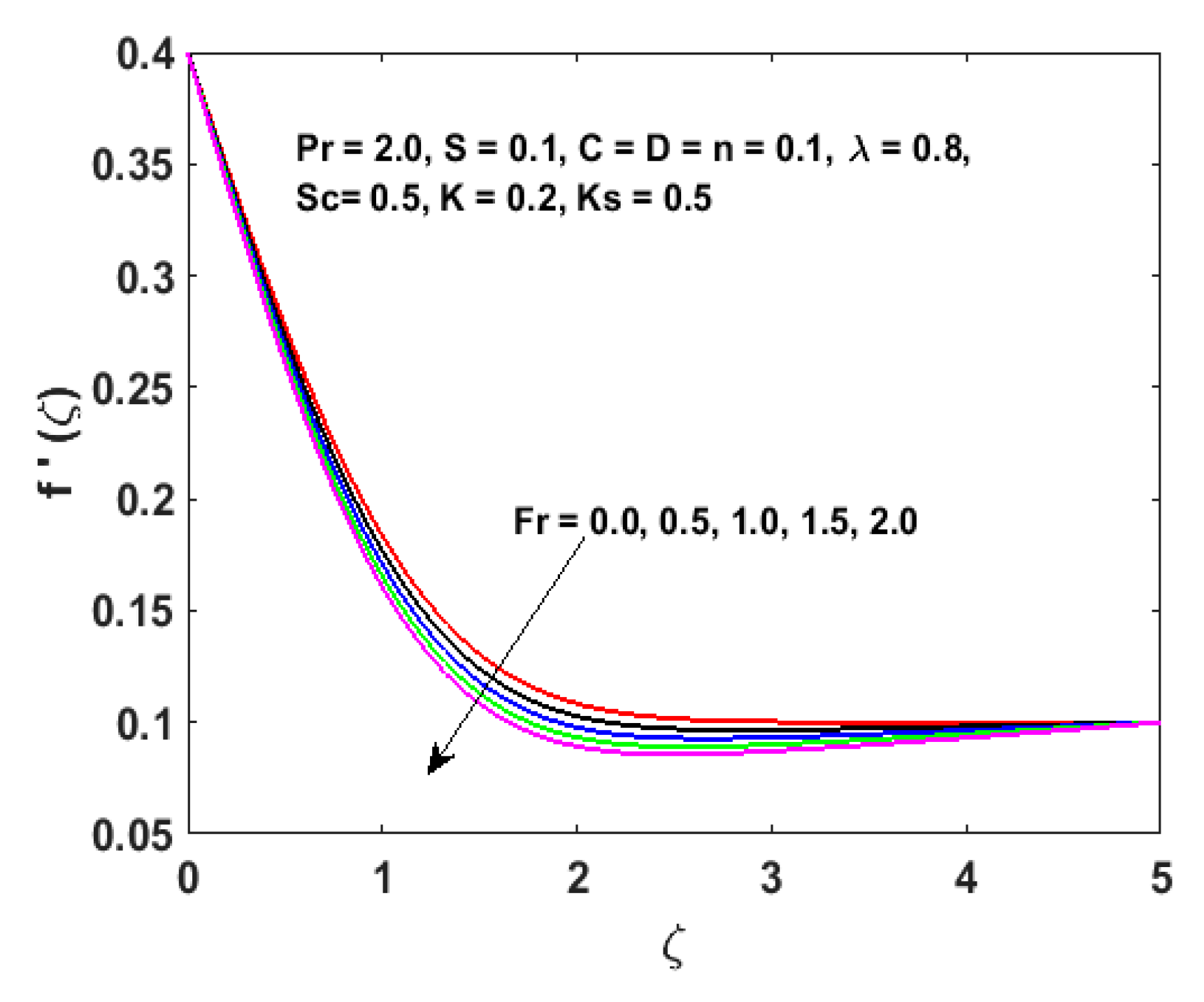
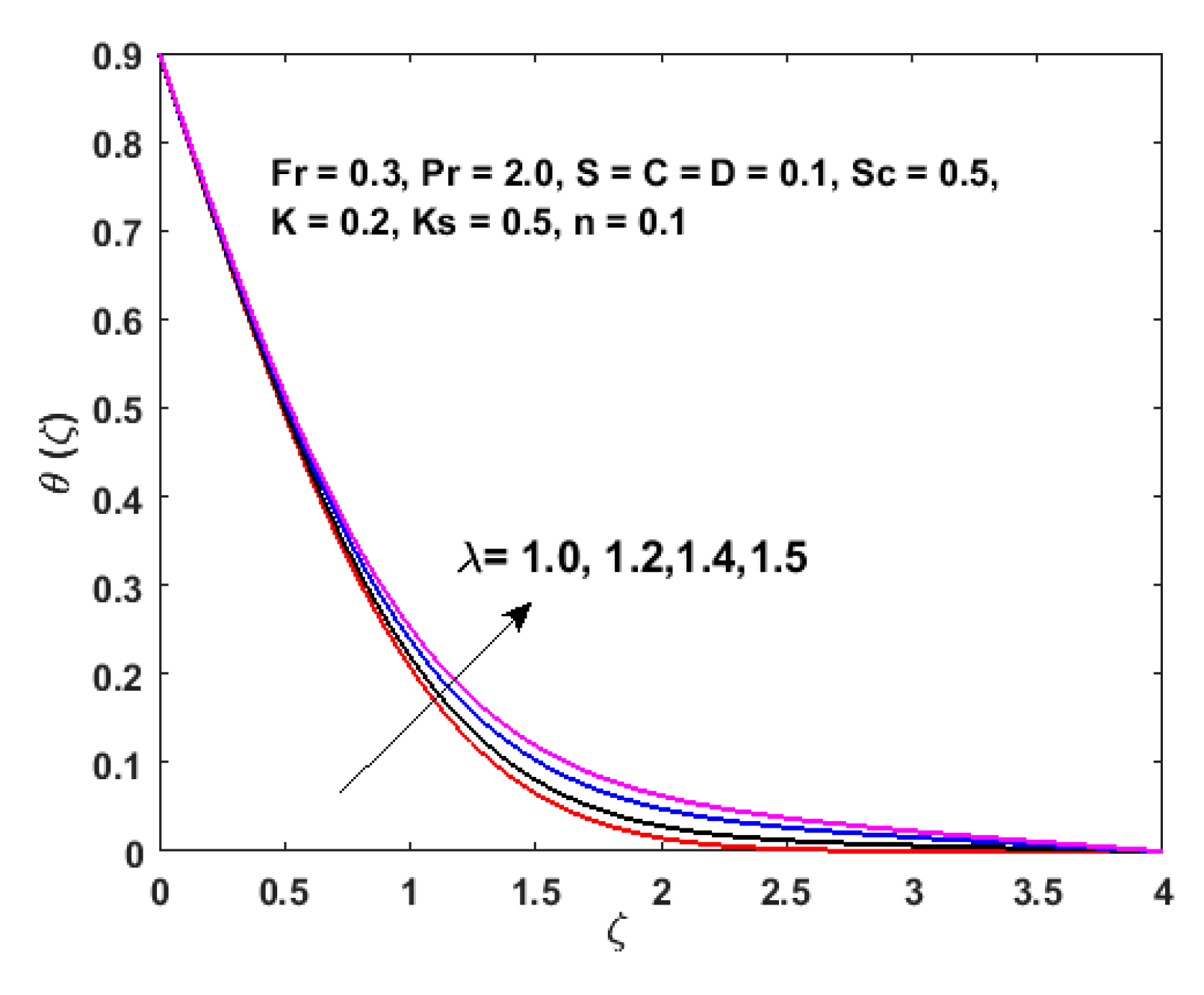

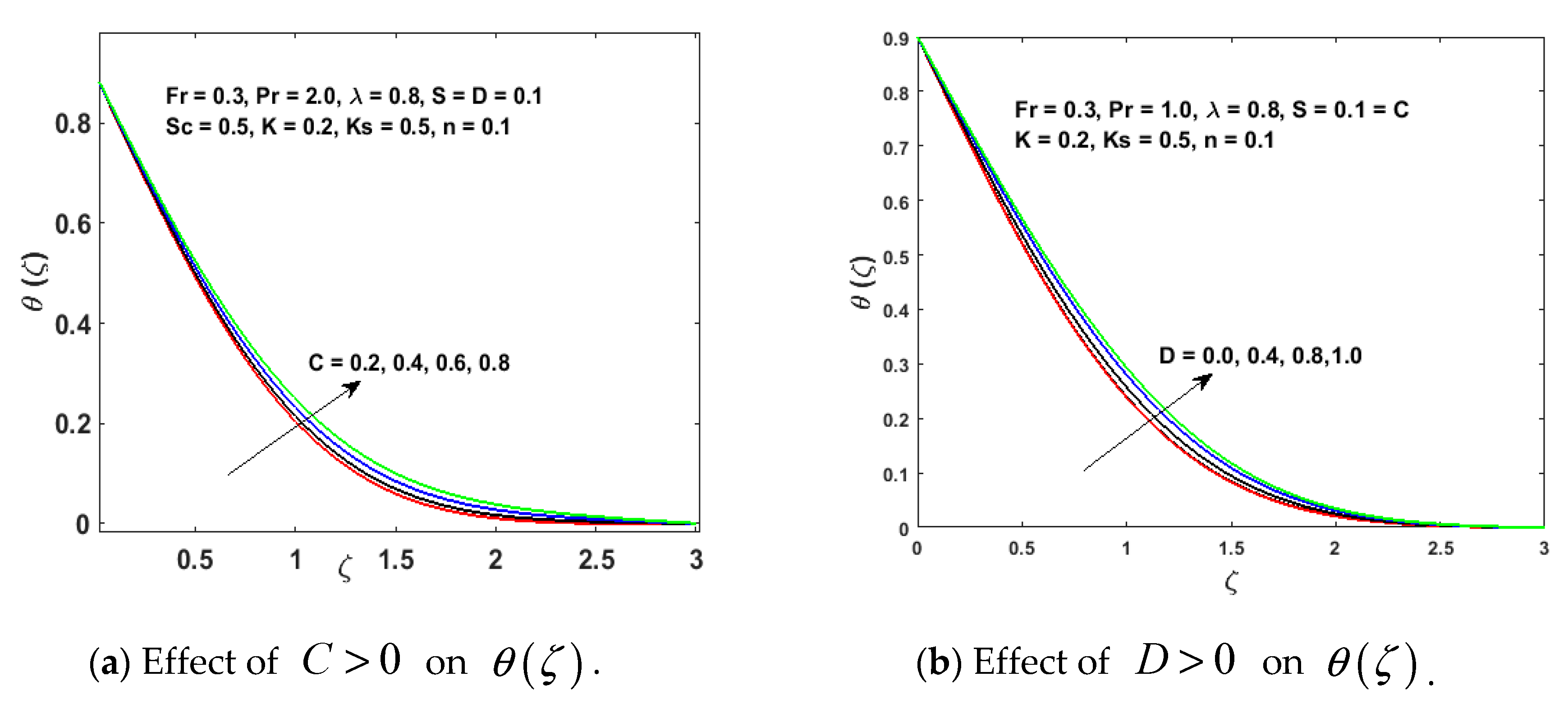
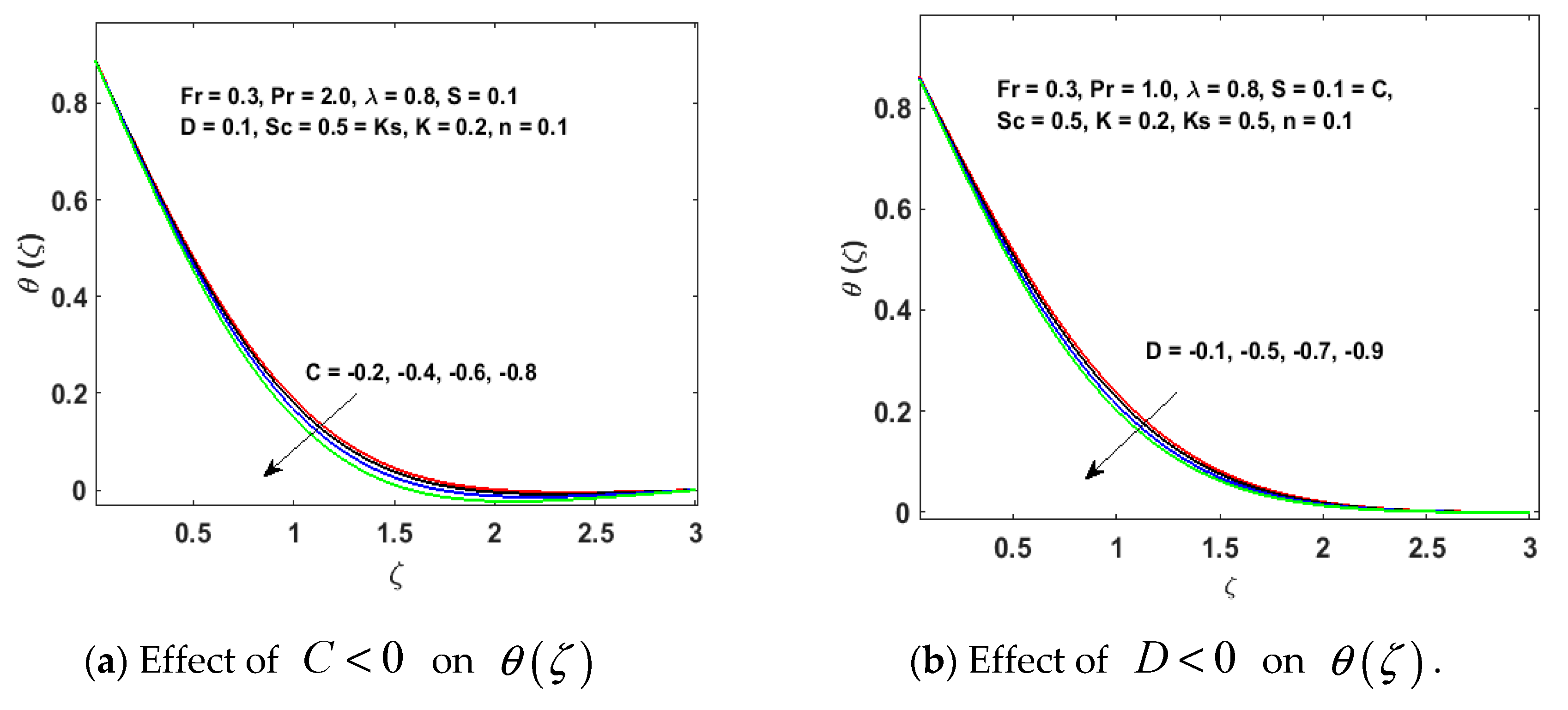
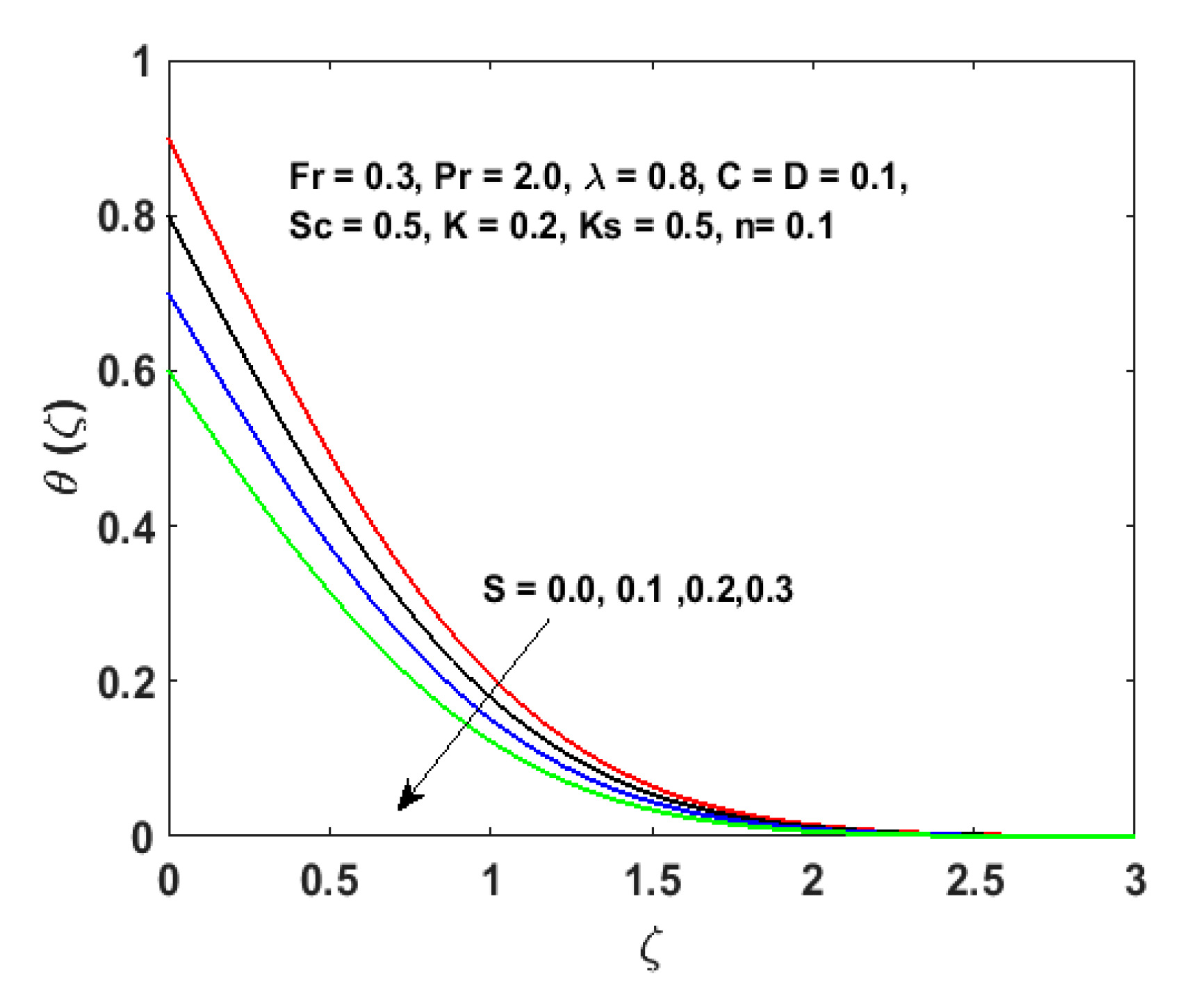
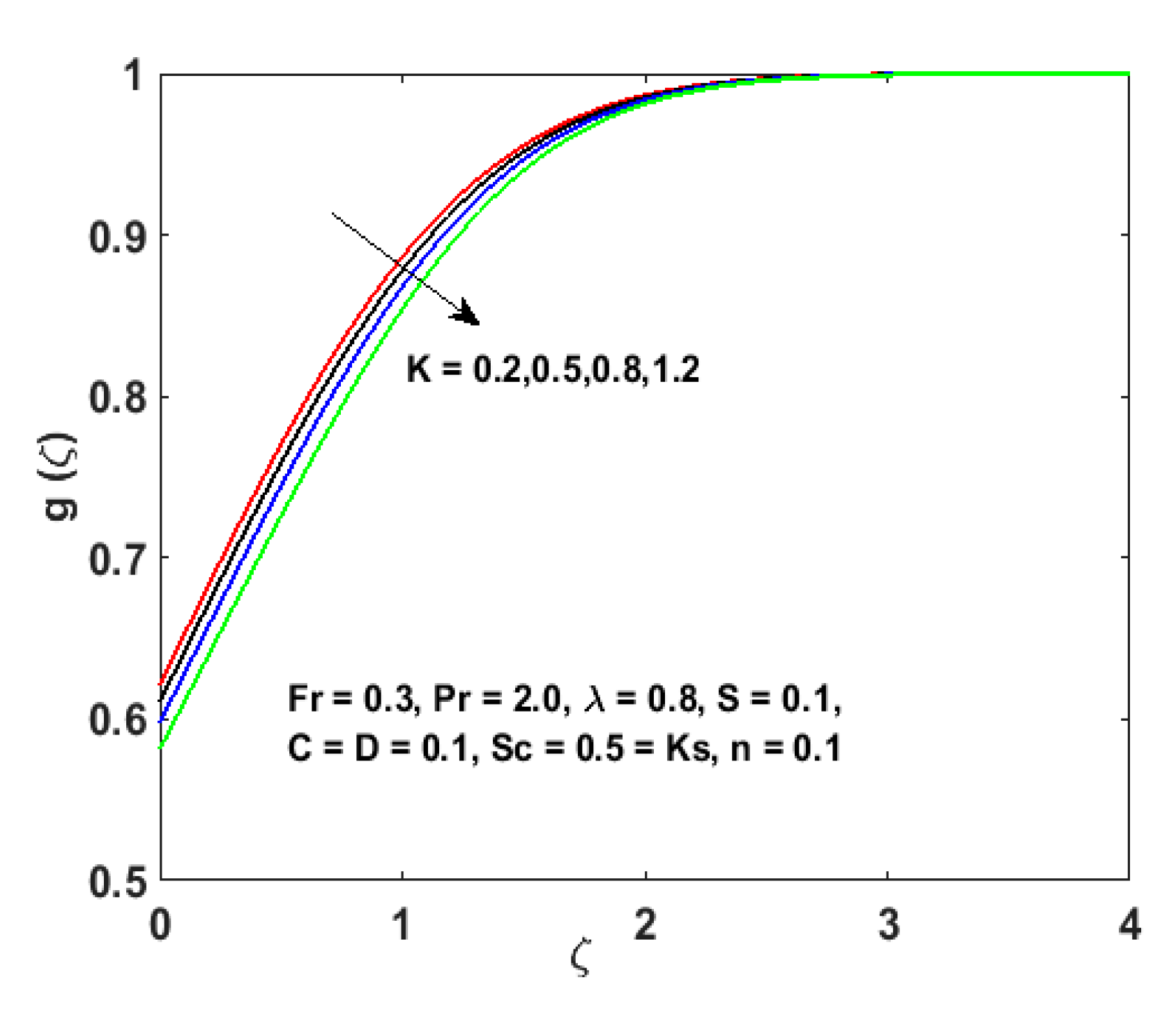


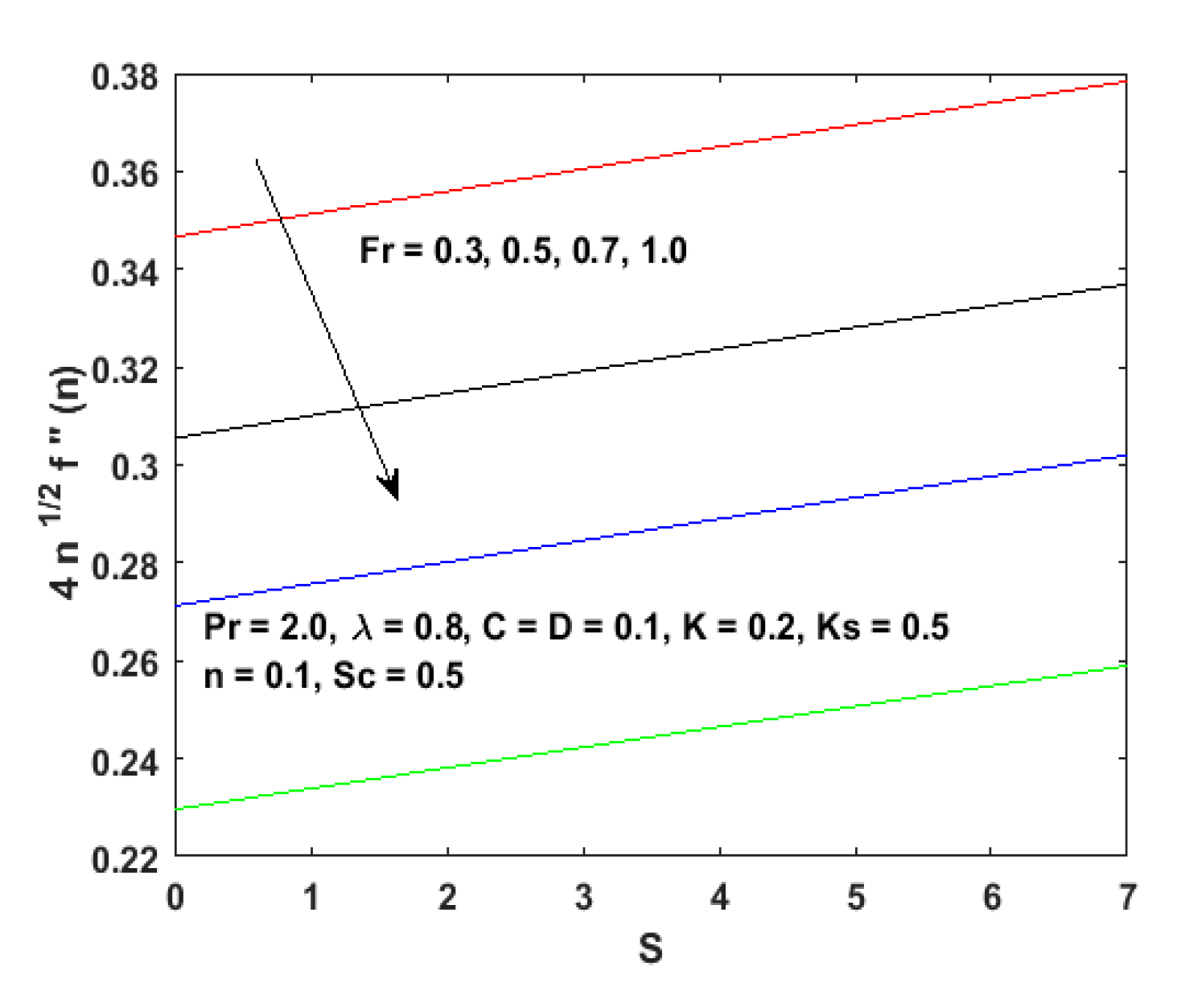

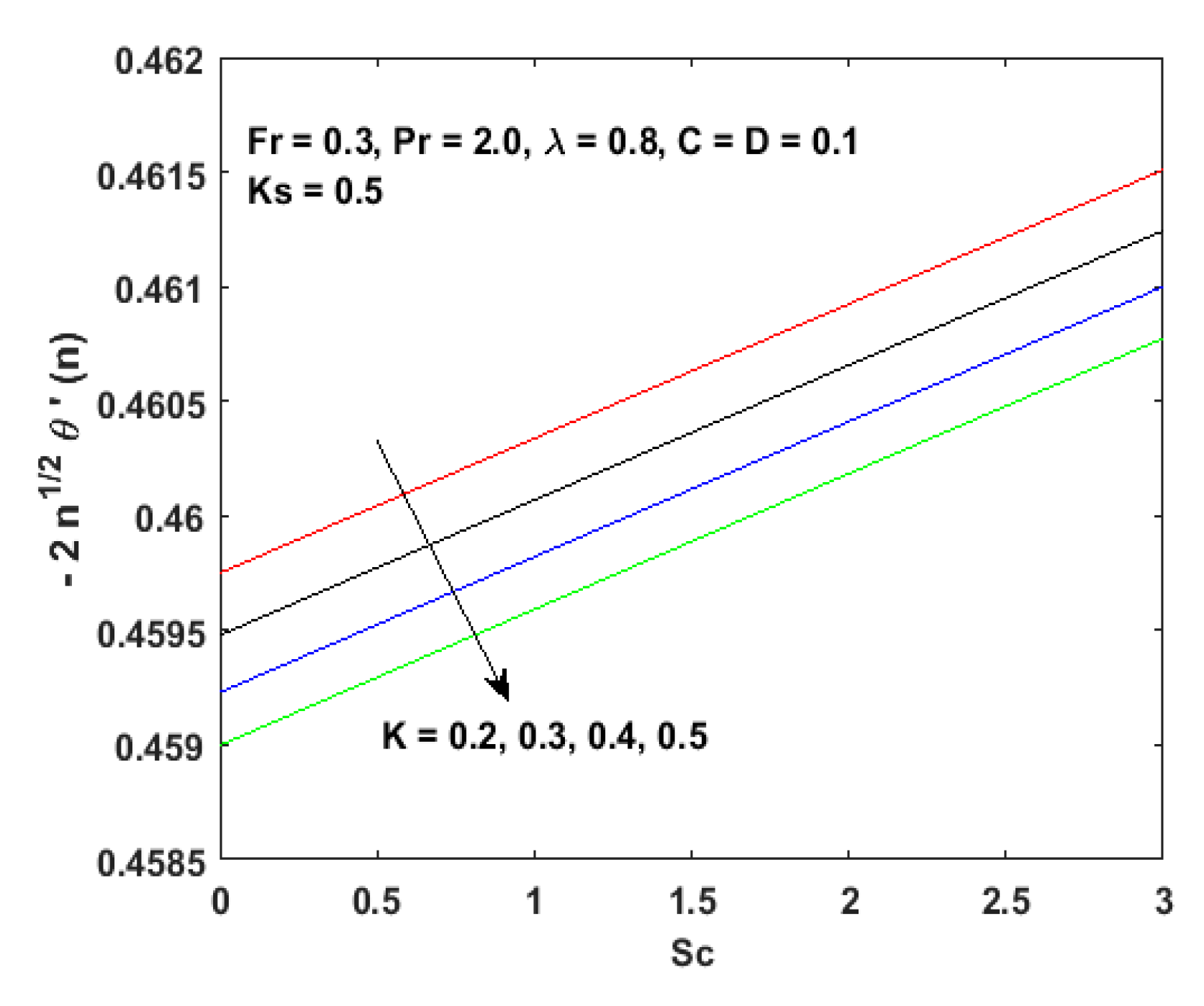
© 2020 by the authors. Licensee MDPI, Basel, Switzerland. This article is an open access article distributed under the terms and conditions of the Creative Commons Attribution (CC BY) license (http://creativecommons.org/licenses/by/4.0/).
Share and Cite
Ramzan, M.; Shaheen, N.; Kadry, S.; Ratha, Y.; Nam, Y. Thermally Stratified Darcy Forchheimer Flow on a Moving Thin Needle with Homogeneous Heterogeneous Reactions and Non-Uniform Heat Source/Sink. Appl. Sci. 2020, 10, 432. https://doi.org/10.3390/app10020432
Ramzan M, Shaheen N, Kadry S, Ratha Y, Nam Y. Thermally Stratified Darcy Forchheimer Flow on a Moving Thin Needle with Homogeneous Heterogeneous Reactions and Non-Uniform Heat Source/Sink. Applied Sciences. 2020; 10(2):432. https://doi.org/10.3390/app10020432
Chicago/Turabian StyleRamzan, Muhammad, Naila Shaheen, Seifedine Kadry, Yeu Ratha, and Yunyoung Nam. 2020. "Thermally Stratified Darcy Forchheimer Flow on a Moving Thin Needle with Homogeneous Heterogeneous Reactions and Non-Uniform Heat Source/Sink" Applied Sciences 10, no. 2: 432. https://doi.org/10.3390/app10020432
APA StyleRamzan, M., Shaheen, N., Kadry, S., Ratha, Y., & Nam, Y. (2020). Thermally Stratified Darcy Forchheimer Flow on a Moving Thin Needle with Homogeneous Heterogeneous Reactions and Non-Uniform Heat Source/Sink. Applied Sciences, 10(2), 432. https://doi.org/10.3390/app10020432







